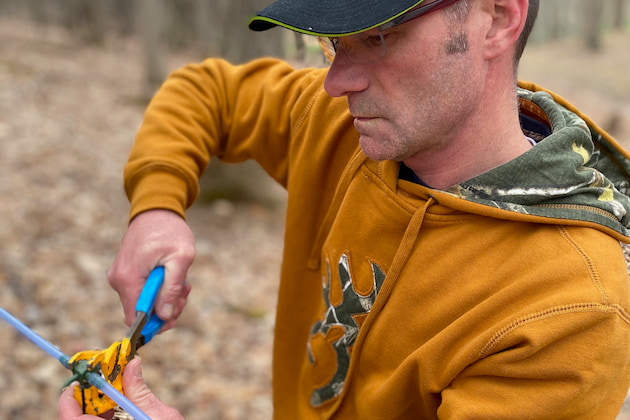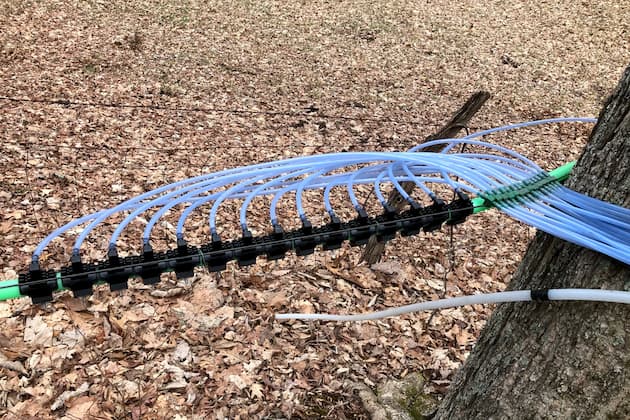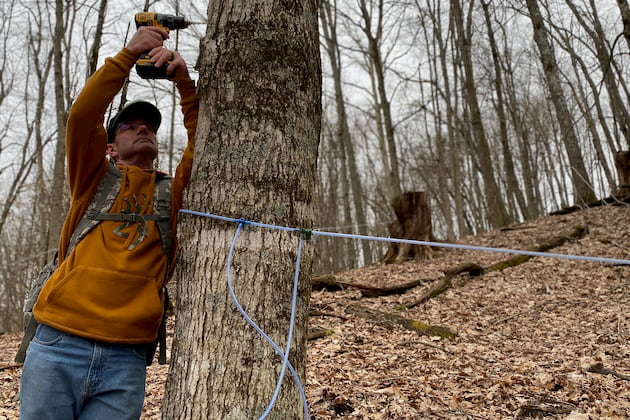Tapping & Tubing
Sugarmaker shares experiences with 3/16 tubing sanitation
How to fight back against the production 'drop off'
By BRANDON DANIELS, CDL WEST VIRGINIA & VIRGINIA | JULY 22, 2020
DAWSON, W.V.—There has been much discussion and some research given to 3/16” and the reduction in flows that most see after the first season.
The information in this article will not be referred to as research, but it will be presented to help maximize your production on 3/16” tubing in seasons two through ten.
Before we jump into that, I will provide a little more information on our facilities and my background.
I started producing maple syrup over thirty years ago with a 2x3 stainless pan in the back yard and ten taps as a young teenager.
This has grown to a modern state of the art operation.
I am running 2,400 taps +/- 10 on 3/16” tubing in five different areas. These taps run into round bottom stainless tanks produced for maple sap.
In all of the areas we have taps, they are within approximately 1.5 miles of each other.
In all five of these locations, there are taps on slopes that face more than one direction and on the 2,400 taps, we have taps that face every direction on the compass.
The spouts used have been three different types of spouts; clear(polycarbonate) seasonal, white nylon spouts and anti-microbial with mostly clear seasonal polycarbonate; we are replacing spouts before every season.
Nearly all of the 3/16” tubing that I will be referring to was installed in 2014 through 2017.
The exceptions to this would be repairs due to damage or some rerouting of 3/16” lateral lines that may have required more tubing to extend. The five areas I will refer to are all on natural vacuum without the aid of any vacuum pump.
One area that has 325 taps on it and has been tapped for over thirty years, had the drop lines replaced on them in just before the 2019 season. The rest of the 3/16” lateral lines, the drops are three to five years old with the exceptions of repairs.
This area of 325 taps that the drop lines were replaced in 2018, are 5/16” drop lines, the remainder of nearly 2,100 taps with three to five year old drop lines with 3/16” drop lines.
All of the 3/16” lateral lines terminate into mainline with none of the lateral lines running directly to a collection tank. Ideally, there should 30’ of drop after the bottom tap on a lateral.
Most of the mainlines are in the bottoms of long hollows or valleys with minimal slope so the lateral lines are terminated into the mainline regardless of how much drop is achieved after the last tap.
100% of the tubing is semi-rigid from CDL and the drops are either CDL semi-rigid or flex which will be addressed in more detail later.
The mainline is the same age as the lateral lines with the exception of one of the areas that has 330 taps on it. This was one of the initial areas 3/16” was installed in 2014 and the mainline is a few years older.
The two main things I want to address is loss of production and plugging in 3/16” tubing.
The research points to a large loss of production after the first season.
Most think it will continue to drop off some every year until the tubing is replaced. I have not experienced the loss of production that research suggests we should and the plugging has been minimal.
In fact, the 2019 season was our record production per tap and this was surpassed by over 18% in 2020.
Over the last three years I have discussed several times with Tim Wilmot, retired maple specialist from UVM Proctor Maple Research Center, why this occurs. Tim is the original developer of 3/16” tubing and presented it to the maple industry.
We have discussed why we think this occurs and I’ll address some of the reasons that I believe this has prevented this from occurring on my properties. Yes, I do see some plugging and usually find about three to four per year in 15 to 20 miles of 3/16” tubing.
In 2020, I only found three areas of plugging and they were all in the 330 tap section that was installed in 2014.
Two of the three areas that were plugged were in a section of tubing that was flat in the middle of the lateral lines and the tank was moved before the 2020 season.
When I rerouted three of these lines to get more slope, the areas of plugging inside the tubing were not seen until well after they were tapped. The other area of plugging was a result of wood chips that had blocked off at a fitting.
Now I want to address why I think most are seeing a reduction in flow and production after the first year. I strive to have all of our taps pulled and lines flushed in five to ten days after the last boil.
This seems to be where many fail, when season is over, most are ready to move onto other things and pulling taps is not high on the list. Over the last six years, I have tried different treatments on pulling and flushing taps.
What I have settled on in 2019, and again in 2020 is simple and easy. I go to the top of every lateral line and pull the top tap which is usually still under vacuum and flush one to two ounces of distilled water through the lateral line.
The vacuum will pull it quickly down the lateral line and help flush out yeast and residue. We then proceed to pull the taps over the next few days and let the drops hang downward and dry for three to six weeks.
As taps are pulled, lateral lines are pushed upward to above head height and this seems to drastically reduce damage to the tubing during the off season. Even though the flushing is easy, it still takes extra time.
Going back a second time to cap off the spouts also creates even more work, but the tubing that was installed in 2014 still looks about as clean as tubing that would have been through one season.
Back in fall of 2017, I replaced a lot of the drops to help “maximize” production. These were all replaced with a flex 3/16” tubing which is more translucent and also easier to work with.
The biggest disadvantage I see to the flex tubing is that it seems to get dirtier easier and retains mold and yeast worse than semi- rigid tubing. I have not had any issues with semi rigid pulling off of fittings and even the original 3/16” fittings that only had one barb on each side of the connection.
Before the 2019 season, the drops were changed in the section with 325 taps with new 5/16” drops except the top tap which was 3/16”.
The most interesting thing I saw from the new 5/16” drops was that they produced less than the older 3/16” drops on the other four sections and less than what they did the prior three years with 3/16” drops which also goes against what research suggests.
I did not see any higher yields during the 2020 season with these one year old 5/16” drops versus the older 3/16” drops.
In a normal season, I usually see syrup yields of around .25 gpt with average sap sugar content of 1.1 to 1.2 for the season.
In 2019, this increased to .276 gpt and in 2020 to .33 gpt. Obviously, there are many factors that come into play with production and you can never duplicate the same conditions from one year to any other year.
The weather was somewhat better in 2019 and 2020 which also helps production. In 2020, the sugar was a little higher than the past three years which contributes to better numbers.
You are welcome to draw your own conclusion from all the information I have presented, but I will give you a good illustration to further reinforce everything.
In January 2018, I had a customer that installed approximately 700 taps on 3/16”. They did not tap until nearly half way through the 2018 season and still made over 1/3 gpt.
In 2019, they installed approximately 300 more taps prior to and during the first part of the 2019 season.
During the season, he called me in distress because he was getting more sap out of the new tubing on 300 taps versus the one year old tubing that had 700 taps. I questioned him if he had been to the woods to check for leaks and he said he did not have time.
A couple of weeks later he called again, really upset that he was not getting much sap out of the 1 year old tubing system even with new spouts. We talked in detail and he finally admitted he did not pull the spouts out from the prior season until the start of the current season.
I explained to him that he probably had a lot of leaks and likely a lot of plugged lines. He agreed to go check out his lines even though the season was winding down. He informed me a couple of days later that he had found quite a bit of damage and a lot of plugged lines.
After fixing the problems and the plugged lines, his sap flow increased dramatically and he pulled all of his taps and flushed his laterals shortly after the season ended in 2019 and he only made .23 gpt.
During the 2020 season, he made nearly .5 gpt without adding any new taps on two and three year old tubing even though nearly everyone reported higher sap flows in 2019 than in 2020.
The only difference, he pulled his spouts out quickly and flushed the lines.
No drops were changed, just new polycarbonate spouts were replaced.
While 3/16” tubing is not for everyone and there are still things we continue to learn, I think sanitation/cleanliness and going the extra mile is extremely important to maximize yields.
Once season ends, most are not eagerly anticipating pulling taps. The additional time and labor of flushing lines and going back a second time to cap off the taps adds up.
I would rather spend some extra time after season when things have slowed down to increase production. I know this all refers to 100% natural vacuum and I am certain that a hybrid system will produce even more sap.
Nearly all of my taps are remote and 100% of the sap is hauled and none of it runs to the sugarhouse.
Up until the 2019 season, every drop was flushed with permeate or distilled water except in 2015 when vinegar and water was used. It is more labor to flush every drop as they are pulled versus flushing the top tap on each 3/16” lateral line.
Discussions that I have had with Tim Wilmot the last three years, we agree that good sanitation and cleaning of 3/16” tubing may be the key in preventing the loss in production.
Unfortunately, due to his retirement, Tim Wilmot did not have the opportunity to do any research or testing on cleaning and sanitation. The tubing seemed to be the cleanest this year with the additional time to air dry and I plan to continue that in the future.
I also think good slope is very important on natural vacuum on 3/16” and not as important with a hybrid system.
Like any good vacuum system, maintenance and fixing leaks is huge in a good 3/16” system. As we start to make plans for the 2021 season and look towards summer, do not forget the old saying: “An ounce of prevention is worth a pound of cure!”


































